Welfare Systems and Services in Australia Research Paper 2022
VerifiedAdded on 2022/10/13
|10
|2005
|22
AI Summary
Contribute Materials
Your contribution can guide someone’s learning journey. Share your
documents today.
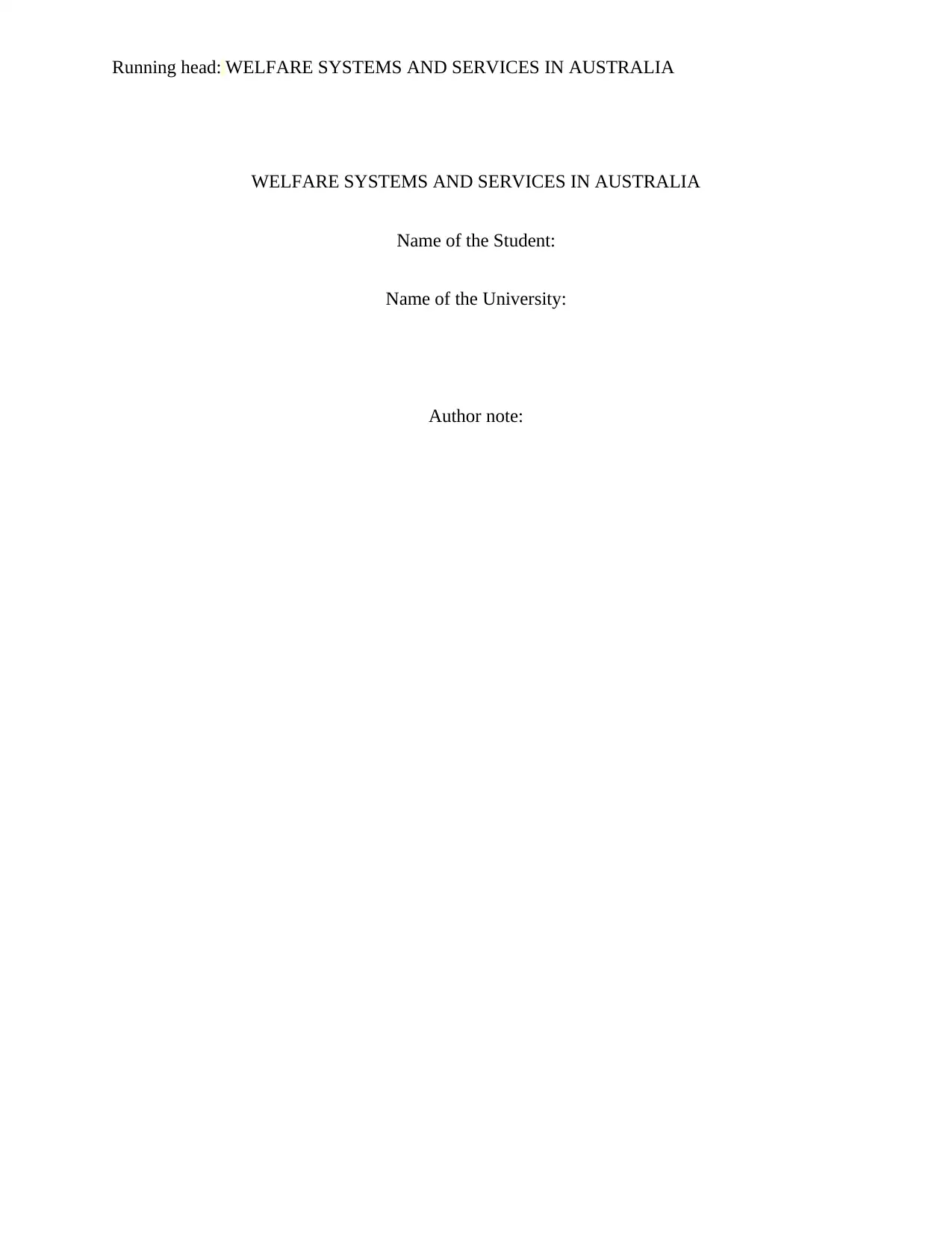
Running head: WELFARE SYSTEMS AND SERVICES IN AUSTRALIA
WELFARE SYSTEMS AND SERVICES IN AUSTRALIA
Name of the Student:
Name of the University:
Author note:
WELFARE SYSTEMS AND SERVICES IN AUSTRALIA
Name of the Student:
Name of the University:
Author note:
Secure Best Marks with AI Grader
Need help grading? Try our AI Grader for instant feedback on your assignments.
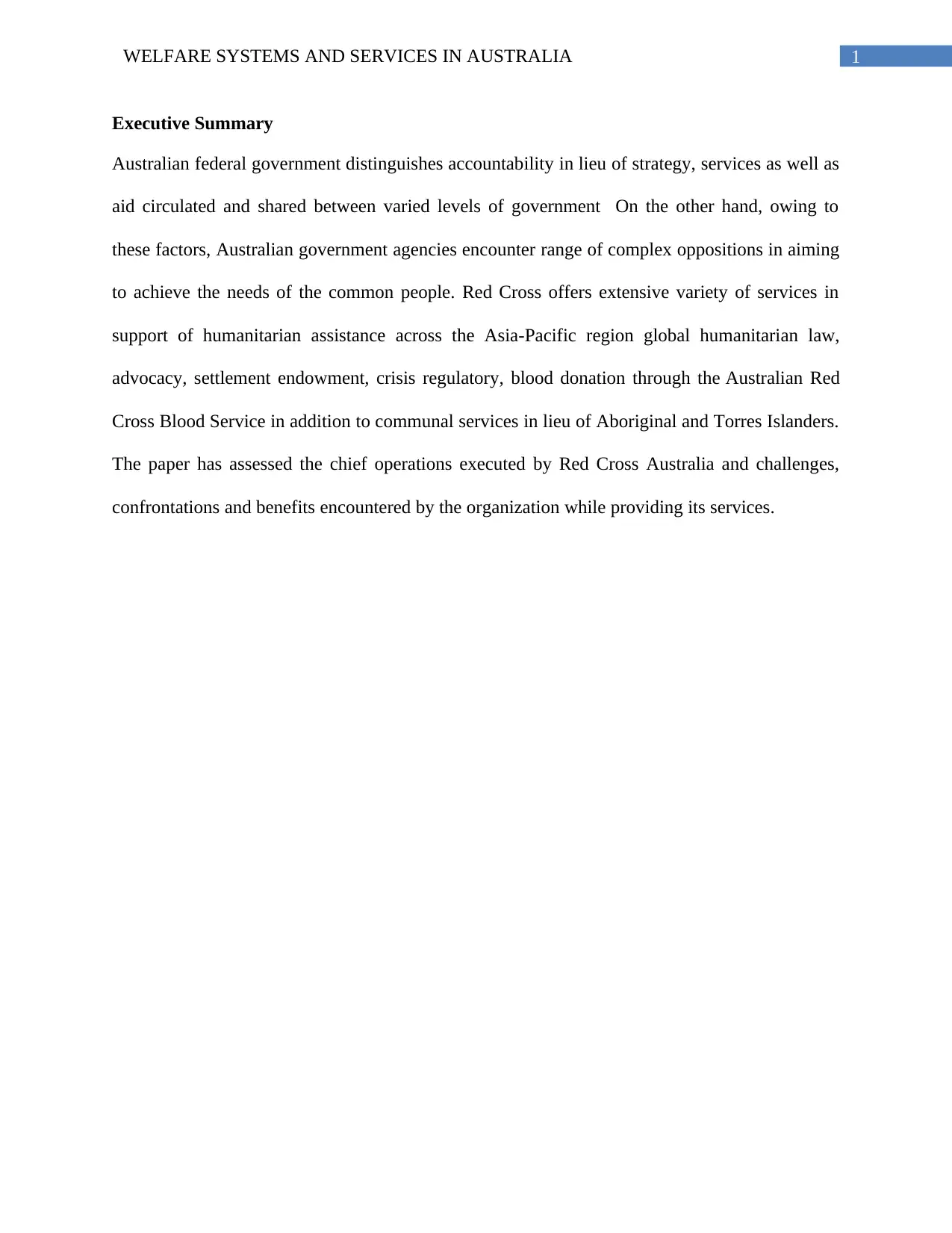
1WELFARE SYSTEMS AND SERVICES IN AUSTRALIA
Executive Summary
Australian federal government distinguishes accountability in lieu of strategy, services as well as
aid circulated and shared between varied levels of government On the other hand, owing to
these factors, Australian government agencies encounter range of complex oppositions in aiming
to achieve the needs of the common people. Red Cross offers extensive variety of services in
support of humanitarian assistance across the Asia-Pacific region global humanitarian law,
advocacy, settlement endowment, crisis regulatory, blood donation through the Australian Red
Cross Blood Service in addition to communal services in lieu of Aboriginal and Torres Islanders.
The paper has assessed the chief operations executed by Red Cross Australia and challenges,
confrontations and benefits encountered by the organization while providing its services.
Executive Summary
Australian federal government distinguishes accountability in lieu of strategy, services as well as
aid circulated and shared between varied levels of government On the other hand, owing to
these factors, Australian government agencies encounter range of complex oppositions in aiming
to achieve the needs of the common people. Red Cross offers extensive variety of services in
support of humanitarian assistance across the Asia-Pacific region global humanitarian law,
advocacy, settlement endowment, crisis regulatory, blood donation through the Australian Red
Cross Blood Service in addition to communal services in lieu of Aboriginal and Torres Islanders.
The paper has assessed the chief operations executed by Red Cross Australia and challenges,
confrontations and benefits encountered by the organization while providing its services.
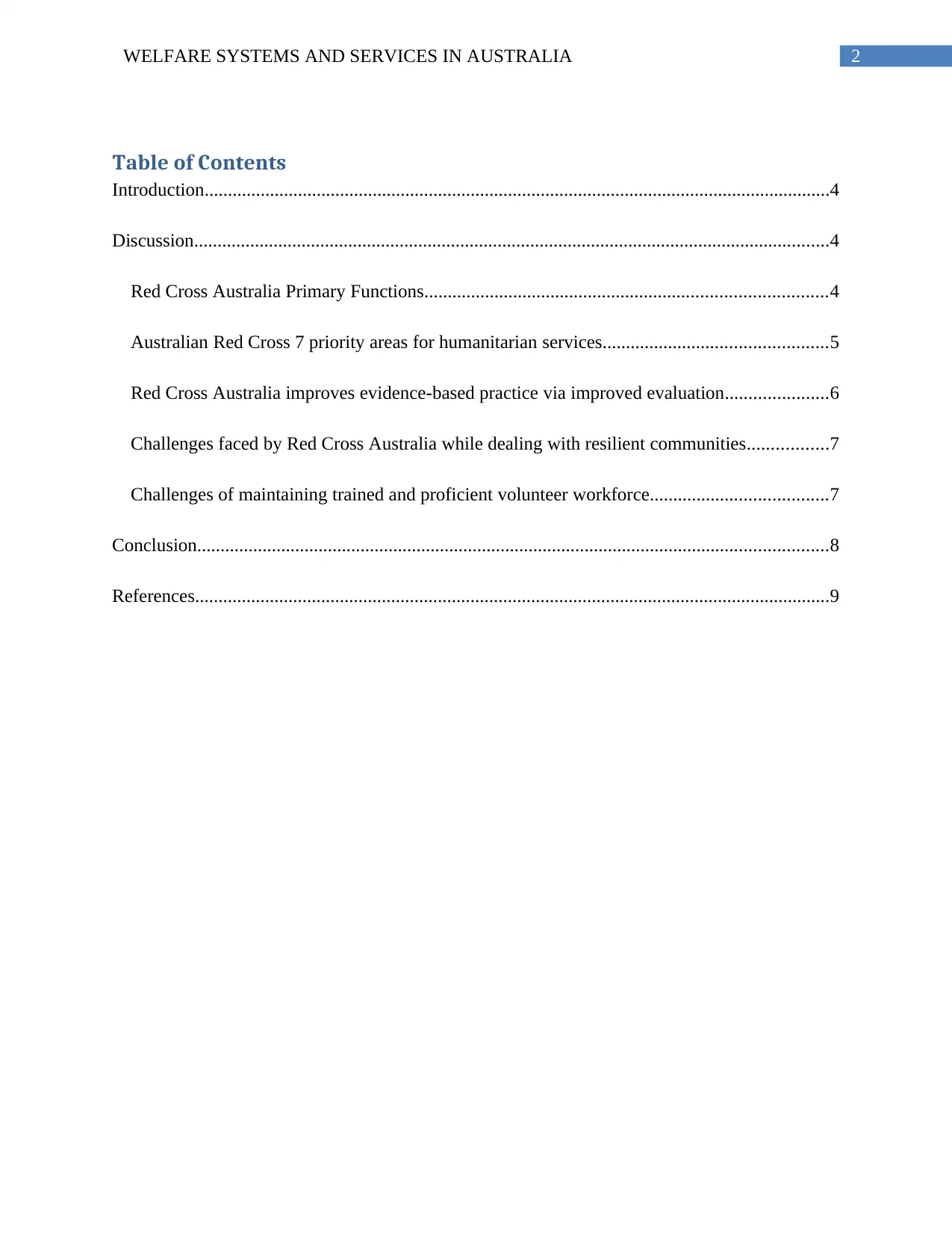
2WELFARE SYSTEMS AND SERVICES IN AUSTRALIA
Table of Contents
Introduction......................................................................................................................................4
Discussion........................................................................................................................................4
Red Cross Australia Primary Functions......................................................................................4
Australian Red Cross 7 priority areas for humanitarian services................................................5
Red Cross Australia improves evidence-based practice via improved evaluation......................6
Challenges faced by Red Cross Australia while dealing with resilient communities.................7
Challenges of maintaining trained and proficient volunteer workforce......................................7
Conclusion.......................................................................................................................................8
References........................................................................................................................................9
Table of Contents
Introduction......................................................................................................................................4
Discussion........................................................................................................................................4
Red Cross Australia Primary Functions......................................................................................4
Australian Red Cross 7 priority areas for humanitarian services................................................5
Red Cross Australia improves evidence-based practice via improved evaluation......................6
Challenges faced by Red Cross Australia while dealing with resilient communities.................7
Challenges of maintaining trained and proficient volunteer workforce......................................7
Conclusion.......................................................................................................................................8
References........................................................................................................................................9
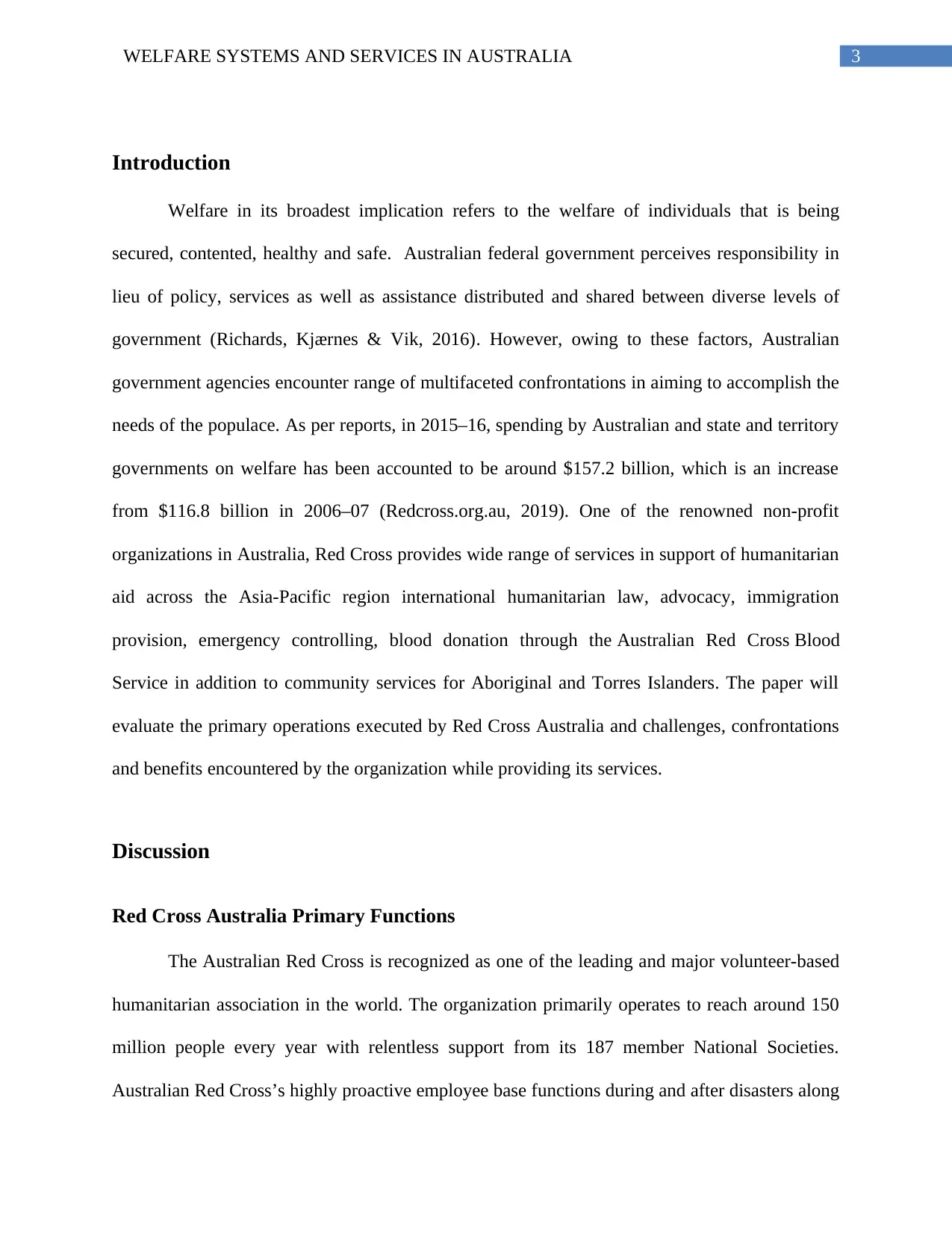
3WELFARE SYSTEMS AND SERVICES IN AUSTRALIA
Introduction
Welfare in its broadest implication refers to the welfare of individuals that is being
secured, contented, healthy and safe. Australian federal government perceives responsibility in
lieu of policy, services as well as assistance distributed and shared between diverse levels of
government (Richards, Kjærnes & Vik, 2016). However, owing to these factors, Australian
government agencies encounter range of multifaceted confrontations in aiming to accomplish the
needs of the populace. As per reports, in 2015–16, spending by Australian and state and territory
governments on welfare has been accounted to be around $157.2 billion, which is an increase
from $116.8 billion in 2006–07 (Redcross.org.au, 2019). One of the renowned non-profit
organizations in Australia, Red Cross provides wide range of services in support of humanitarian
aid across the Asia-Pacific region international humanitarian law, advocacy, immigration
provision, emergency controlling, blood donation through the Australian Red Cross Blood
Service in addition to community services for Aboriginal and Torres Islanders. The paper will
evaluate the primary operations executed by Red Cross Australia and challenges, confrontations
and benefits encountered by the organization while providing its services.
Discussion
Red Cross Australia Primary Functions
The Australian Red Cross is recognized as one of the leading and major volunteer-based
humanitarian association in the world. The organization primarily operates to reach around 150
million people every year with relentless support from its 187 member National Societies.
Australian Red Cross’s highly proactive employee base functions during and after disasters along
Introduction
Welfare in its broadest implication refers to the welfare of individuals that is being
secured, contented, healthy and safe. Australian federal government perceives responsibility in
lieu of policy, services as well as assistance distributed and shared between diverse levels of
government (Richards, Kjærnes & Vik, 2016). However, owing to these factors, Australian
government agencies encounter range of multifaceted confrontations in aiming to accomplish the
needs of the populace. As per reports, in 2015–16, spending by Australian and state and territory
governments on welfare has been accounted to be around $157.2 billion, which is an increase
from $116.8 billion in 2006–07 (Redcross.org.au, 2019). One of the renowned non-profit
organizations in Australia, Red Cross provides wide range of services in support of humanitarian
aid across the Asia-Pacific region international humanitarian law, advocacy, immigration
provision, emergency controlling, blood donation through the Australian Red Cross Blood
Service in addition to community services for Aboriginal and Torres Islanders. The paper will
evaluate the primary operations executed by Red Cross Australia and challenges, confrontations
and benefits encountered by the organization while providing its services.
Discussion
Red Cross Australia Primary Functions
The Australian Red Cross is recognized as one of the leading and major volunteer-based
humanitarian association in the world. The organization primarily operates to reach around 150
million people every year with relentless support from its 187 member National Societies.
Australian Red Cross’s highly proactive employee base functions during and after disasters along
Secure Best Marks with AI Grader
Need help grading? Try our AI Grader for instant feedback on your assignments.

4WELFARE SYSTEMS AND SERVICES IN AUSTRALIA
with health emergencies in order to efficiently attain the needs and improve the lives of
susceptible individuals (AIHW.gov.au, 2019). Reports reveal that Red Cross Australia shows
great inclination to partake in enterprises leading to measurement systems which enlighten
Australians regrading current activities and occurrences within the society. According to authors,
Red Cross through its constant initiation has provided an improved explanation of the problems
people have been encountering beyond production-oriented and economic archetype.
Accordingly, Red Cross recognizes a comprehensive directive for the Australian Bureau of
Statistics in relation to the type of statistical frameworks it sets up to regarding the way the
organization is carrying out as a society and not only as a budget in addition to the role and
comparative aid of the not-for-profit division within this (Cheers, 2019). By taking into
consideration its Strategy for 2020, Australian Red Cross’s strategy is to rapidly respond to the
changing humanitarian needs in support of the Australian community.
Australian Red Cross 7 priority areas for humanitarian services
Reinforcement of national emergency vigilance, response and recovery
Cumulative global aid and expansion chiefly in Asia and the Pacific regions
Supporting global humanitarian regulation
Focusing on the impact of immigration
Functioning with Aboriginal and Torres Strait Islander populaces
Overcoming social segregation and marginalization by providing connections back into
the community
Engaging with youth, families as well as societies in regions of locational shortcoming
As per reports, Australian Red Cross principally runs blood service as a distinct division,
authoritatively establishing an eighth priority area. The blood service constitutes of its own board
with health emergencies in order to efficiently attain the needs and improve the lives of
susceptible individuals (AIHW.gov.au, 2019). Reports reveal that Red Cross Australia shows
great inclination to partake in enterprises leading to measurement systems which enlighten
Australians regrading current activities and occurrences within the society. According to authors,
Red Cross through its constant initiation has provided an improved explanation of the problems
people have been encountering beyond production-oriented and economic archetype.
Accordingly, Red Cross recognizes a comprehensive directive for the Australian Bureau of
Statistics in relation to the type of statistical frameworks it sets up to regarding the way the
organization is carrying out as a society and not only as a budget in addition to the role and
comparative aid of the not-for-profit division within this (Cheers, 2019). By taking into
consideration its Strategy for 2020, Australian Red Cross’s strategy is to rapidly respond to the
changing humanitarian needs in support of the Australian community.
Australian Red Cross 7 priority areas for humanitarian services
Reinforcement of national emergency vigilance, response and recovery
Cumulative global aid and expansion chiefly in Asia and the Pacific regions
Supporting global humanitarian regulation
Focusing on the impact of immigration
Functioning with Aboriginal and Torres Strait Islander populaces
Overcoming social segregation and marginalization by providing connections back into
the community
Engaging with youth, families as well as societies in regions of locational shortcoming
As per reports, Australian Red Cross principally runs blood service as a distinct division,
authoritatively establishing an eighth priority area. The blood service constitutes of its own board
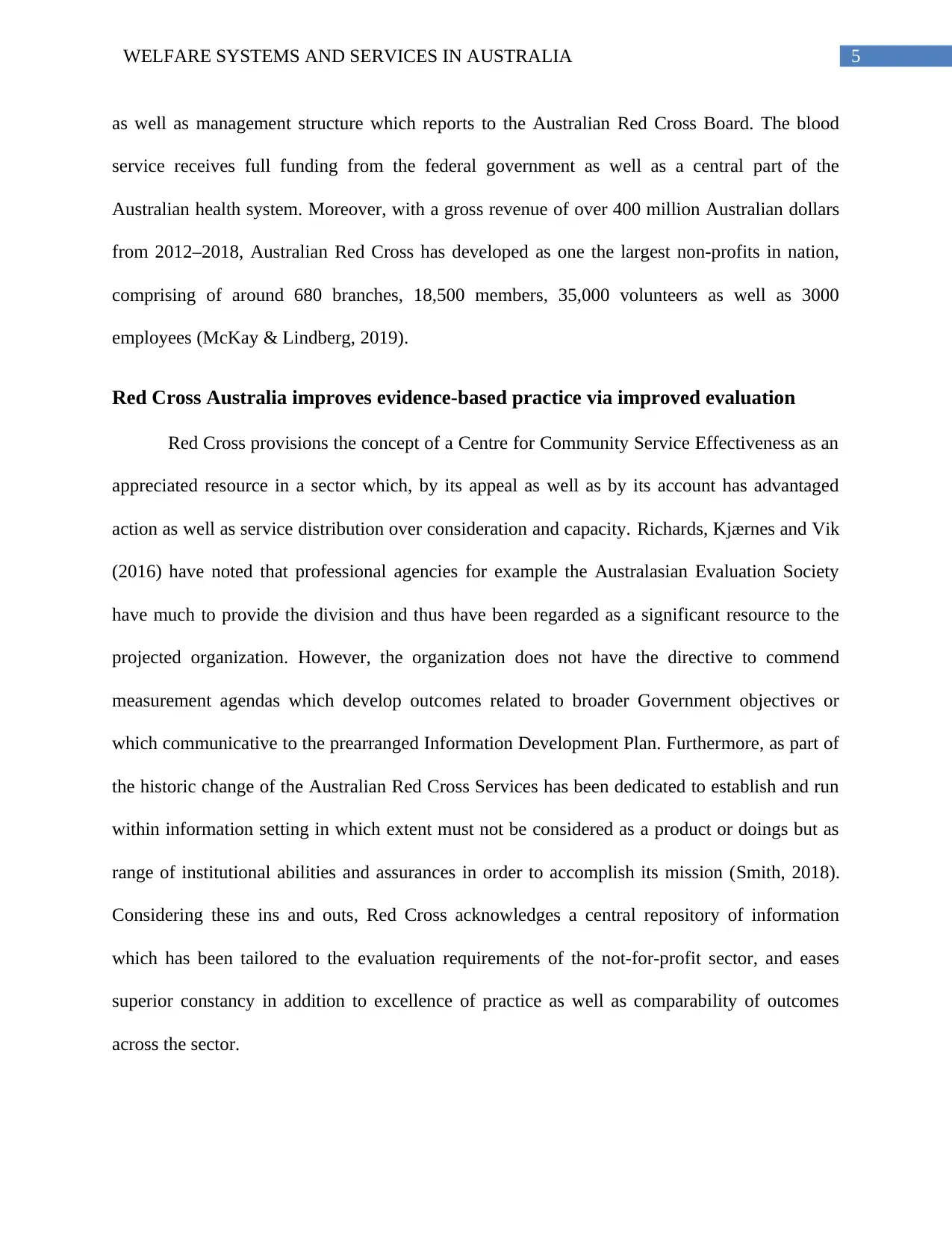
5WELFARE SYSTEMS AND SERVICES IN AUSTRALIA
as well as management structure which reports to the Australian Red Cross Board. The blood
service receives full funding from the federal government as well as a central part of the
Australian health system. Moreover, with a gross revenue of over 400 million Australian dollars
from 2012–2018, Australian Red Cross has developed as one the largest non-profits in nation,
comprising of around 680 branches, 18,500 members, 35,000 volunteers as well as 3000
employees (McKay & Lindberg, 2019).
Red Cross Australia improves evidence-based practice via improved evaluation
Red Cross provisions the concept of a Centre for Community Service Effectiveness as an
appreciated resource in a sector which, by its appeal as well as by its account has advantaged
action as well as service distribution over consideration and capacity. Richards, Kjærnes and Vik
(2016) have noted that professional agencies for example the Australasian Evaluation Society
have much to provide the division and thus have been regarded as a significant resource to the
projected organization. However, the organization does not have the directive to commend
measurement agendas which develop outcomes related to broader Government objectives or
which communicative to the prearranged Information Development Plan. Furthermore, as part of
the historic change of the Australian Red Cross Services has been dedicated to establish and run
within information setting in which extent must not be considered as a product or doings but as
range of institutional abilities and assurances in order to accomplish its mission (Smith, 2018).
Considering these ins and outs, Red Cross acknowledges a central repository of information
which has been tailored to the evaluation requirements of the not-for-profit sector, and eases
superior constancy in addition to excellence of practice as well as comparability of outcomes
across the sector.
as well as management structure which reports to the Australian Red Cross Board. The blood
service receives full funding from the federal government as well as a central part of the
Australian health system. Moreover, with a gross revenue of over 400 million Australian dollars
from 2012–2018, Australian Red Cross has developed as one the largest non-profits in nation,
comprising of around 680 branches, 18,500 members, 35,000 volunteers as well as 3000
employees (McKay & Lindberg, 2019).
Red Cross Australia improves evidence-based practice via improved evaluation
Red Cross provisions the concept of a Centre for Community Service Effectiveness as an
appreciated resource in a sector which, by its appeal as well as by its account has advantaged
action as well as service distribution over consideration and capacity. Richards, Kjærnes and Vik
(2016) have noted that professional agencies for example the Australasian Evaluation Society
have much to provide the division and thus have been regarded as a significant resource to the
projected organization. However, the organization does not have the directive to commend
measurement agendas which develop outcomes related to broader Government objectives or
which communicative to the prearranged Information Development Plan. Furthermore, as part of
the historic change of the Australian Red Cross Services has been dedicated to establish and run
within information setting in which extent must not be considered as a product or doings but as
range of institutional abilities and assurances in order to accomplish its mission (Smith, 2018).
Considering these ins and outs, Red Cross acknowledges a central repository of information
which has been tailored to the evaluation requirements of the not-for-profit sector, and eases
superior constancy in addition to excellence of practice as well as comparability of outcomes
across the sector.
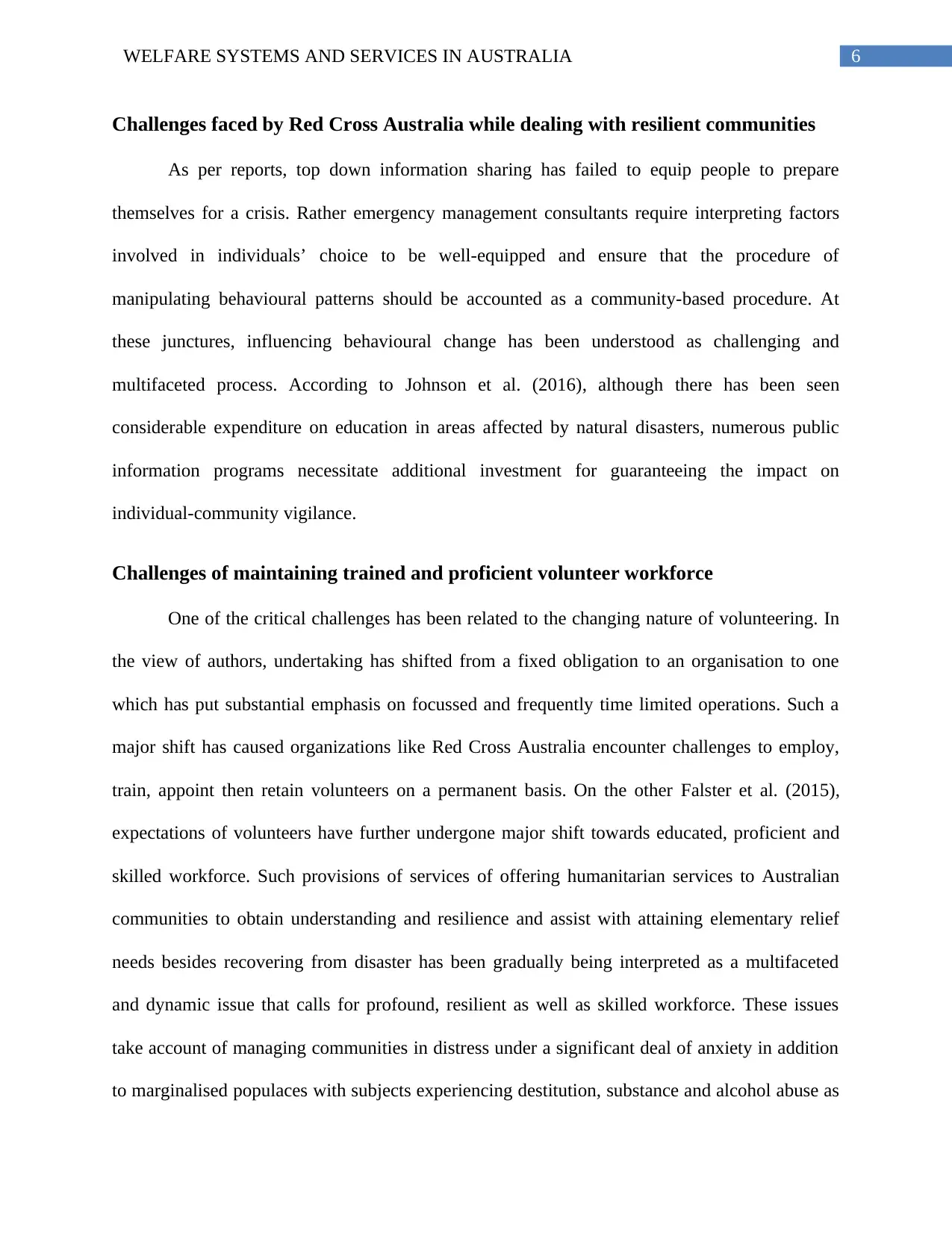
6WELFARE SYSTEMS AND SERVICES IN AUSTRALIA
Challenges faced by Red Cross Australia while dealing with resilient communities
As per reports, top down information sharing has failed to equip people to prepare
themselves for a crisis. Rather emergency management consultants require interpreting factors
involved in individuals’ choice to be well-equipped and ensure that the procedure of
manipulating behavioural patterns should be accounted as a community-based procedure. At
these junctures, influencing behavioural change has been understood as challenging and
multifaceted process. According to Johnson et al. (2016), although there has been seen
considerable expenditure on education in areas affected by natural disasters, numerous public
information programs necessitate additional investment for guaranteeing the impact on
individual-community vigilance.
Challenges of maintaining trained and proficient volunteer workforce
One of the critical challenges has been related to the changing nature of volunteering. In
the view of authors, undertaking has shifted from a fixed obligation to an organisation to one
which has put substantial emphasis on focussed and frequently time limited operations. Such a
major shift has caused organizations like Red Cross Australia encounter challenges to employ,
train, appoint then retain volunteers on a permanent basis. On the other Falster et al. (2015),
expectations of volunteers have further undergone major shift towards educated, proficient and
skilled workforce. Such provisions of services of offering humanitarian services to Australian
communities to obtain understanding and resilience and assist with attaining elementary relief
needs besides recovering from disaster has been gradually being interpreted as a multifaceted
and dynamic issue that calls for profound, resilient as well as skilled workforce. These issues
take account of managing communities in distress under a significant deal of anxiety in addition
to marginalised populaces with subjects experiencing destitution, substance and alcohol abuse as
Challenges faced by Red Cross Australia while dealing with resilient communities
As per reports, top down information sharing has failed to equip people to prepare
themselves for a crisis. Rather emergency management consultants require interpreting factors
involved in individuals’ choice to be well-equipped and ensure that the procedure of
manipulating behavioural patterns should be accounted as a community-based procedure. At
these junctures, influencing behavioural change has been understood as challenging and
multifaceted process. According to Johnson et al. (2016), although there has been seen
considerable expenditure on education in areas affected by natural disasters, numerous public
information programs necessitate additional investment for guaranteeing the impact on
individual-community vigilance.
Challenges of maintaining trained and proficient volunteer workforce
One of the critical challenges has been related to the changing nature of volunteering. In
the view of authors, undertaking has shifted from a fixed obligation to an organisation to one
which has put substantial emphasis on focussed and frequently time limited operations. Such a
major shift has caused organizations like Red Cross Australia encounter challenges to employ,
train, appoint then retain volunteers on a permanent basis. On the other Falster et al. (2015),
expectations of volunteers have further undergone major shift towards educated, proficient and
skilled workforce. Such provisions of services of offering humanitarian services to Australian
communities to obtain understanding and resilience and assist with attaining elementary relief
needs besides recovering from disaster has been gradually being interpreted as a multifaceted
and dynamic issue that calls for profound, resilient as well as skilled workforce. These issues
take account of managing communities in distress under a significant deal of anxiety in addition
to marginalised populaces with subjects experiencing destitution, substance and alcohol abuse as
Paraphrase This Document
Need a fresh take? Get an instant paraphrase of this document with our AI Paraphraser

7WELFARE SYSTEMS AND SERVICES IN AUSTRALIA
well as mental disorder (Mau, 2017). Such a recognition points towards a need to shift the view
of emergency liberation from a ‘welfare” attitude of dealing distressed communities and further
identifying that these situations exhibit utmost unpredictability and have involves risk element.
Furthermore, people experiencing these tragedies have the right to be considered with utmost
dignity and have multifaceted wants that necessitate capable workers to manage efficiently
(Smith, 2018). Moreover, if voluntary organisations focus on building capacity as well as
community flexibility, then concentrating on preparation and progress of quality roles can be
further operative rather than aggregating the number of volunteers.
Conclusion
Hence to conclude, Australian Red Cross has been progressively seeking to guarantee
commitments set up by them are effusively exemplified in their relationship with government. It
has been noted that in the global emergencies sphere, this has been accomplished through official
acknowledgment by AusAID of the exceptional secondary role of Red Cross in the whole of
administration Humanitarian Action Plan. Red Cross Australia seeks to add value to the
humanitarian actions which communities freely accept on local, regional, domestic and global
problems.
well as mental disorder (Mau, 2017). Such a recognition points towards a need to shift the view
of emergency liberation from a ‘welfare” attitude of dealing distressed communities and further
identifying that these situations exhibit utmost unpredictability and have involves risk element.
Furthermore, people experiencing these tragedies have the right to be considered with utmost
dignity and have multifaceted wants that necessitate capable workers to manage efficiently
(Smith, 2018). Moreover, if voluntary organisations focus on building capacity as well as
community flexibility, then concentrating on preparation and progress of quality roles can be
further operative rather than aggregating the number of volunteers.
Conclusion
Hence to conclude, Australian Red Cross has been progressively seeking to guarantee
commitments set up by them are effusively exemplified in their relationship with government. It
has been noted that in the global emergencies sphere, this has been accomplished through official
acknowledgment by AusAID of the exceptional secondary role of Red Cross in the whole of
administration Humanitarian Action Plan. Red Cross Australia seeks to add value to the
humanitarian actions which communities freely accept on local, regional, domestic and global
problems.
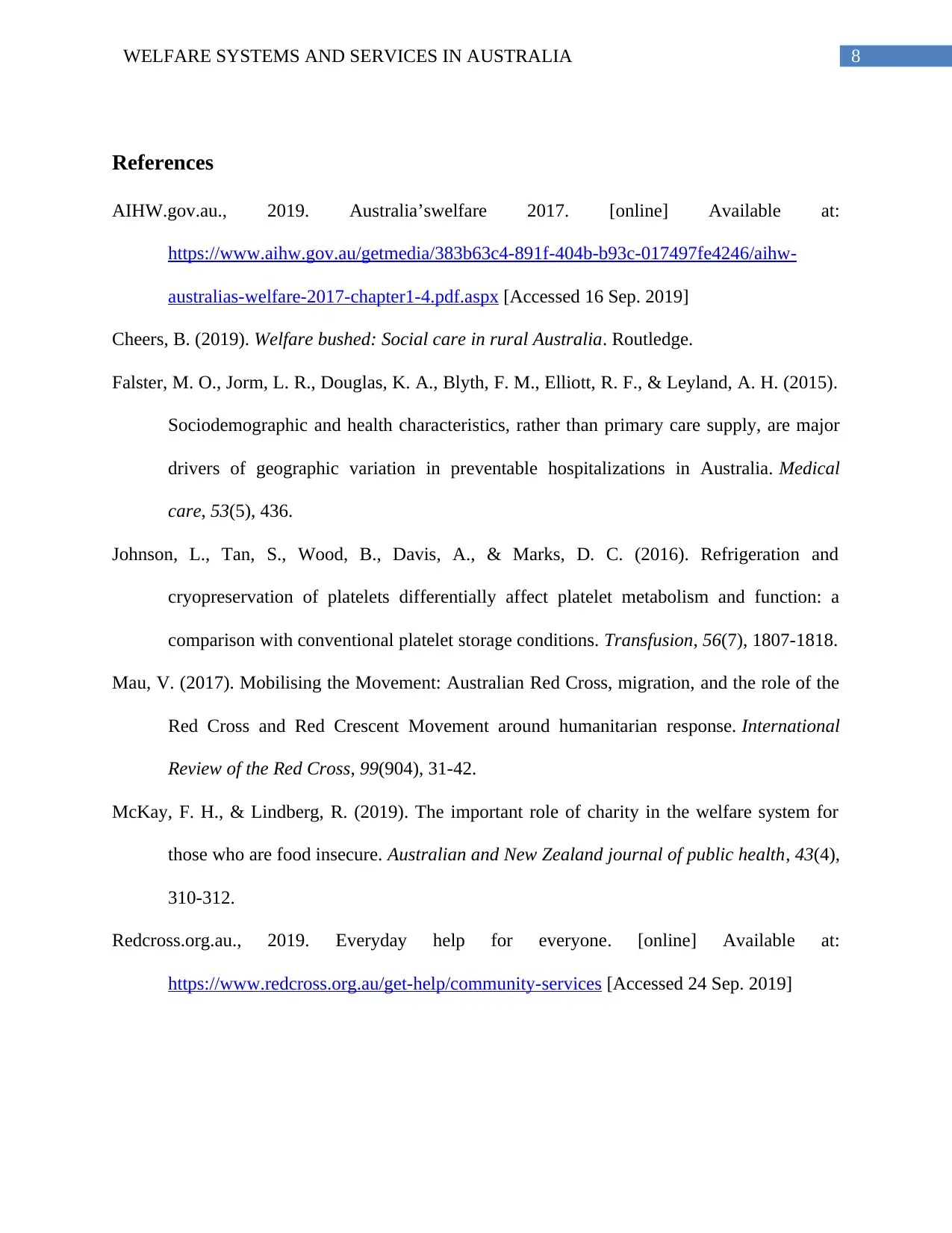
8WELFARE SYSTEMS AND SERVICES IN AUSTRALIA
References
AIHW.gov.au., 2019. Australia’swelfare 2017. [online] Available at:
https://www.aihw.gov.au/getmedia/383b63c4-891f-404b-b93c-017497fe4246/aihw-
australias-welfare-2017-chapter1-4.pdf.aspx [Accessed 16 Sep. 2019]
Cheers, B. (2019). Welfare bushed: Social care in rural Australia. Routledge.
Falster, M. O., Jorm, L. R., Douglas, K. A., Blyth, F. M., Elliott, R. F., & Leyland, A. H. (2015).
Sociodemographic and health characteristics, rather than primary care supply, are major
drivers of geographic variation in preventable hospitalizations in Australia. Medical
care, 53(5), 436.
Johnson, L., Tan, S., Wood, B., Davis, A., & Marks, D. C. (2016). Refrigeration and
cryopreservation of platelets differentially affect platelet metabolism and function: a
comparison with conventional platelet storage conditions. Transfusion, 56(7), 1807-1818.
Mau, V. (2017). Mobilising the Movement: Australian Red Cross, migration, and the role of the
Red Cross and Red Crescent Movement around humanitarian response. International
Review of the Red Cross, 99(904), 31-42.
McKay, F. H., & Lindberg, R. (2019). The important role of charity in the welfare system for
those who are food insecure. Australian and New Zealand journal of public health, 43(4),
310-312.
Redcross.org.au., 2019. Everyday help for everyone. [online] Available at:
https://www.redcross.org.au/get-help/community-services [Accessed 24 Sep. 2019]
References
AIHW.gov.au., 2019. Australia’swelfare 2017. [online] Available at:
https://www.aihw.gov.au/getmedia/383b63c4-891f-404b-b93c-017497fe4246/aihw-
australias-welfare-2017-chapter1-4.pdf.aspx [Accessed 16 Sep. 2019]
Cheers, B. (2019). Welfare bushed: Social care in rural Australia. Routledge.
Falster, M. O., Jorm, L. R., Douglas, K. A., Blyth, F. M., Elliott, R. F., & Leyland, A. H. (2015).
Sociodemographic and health characteristics, rather than primary care supply, are major
drivers of geographic variation in preventable hospitalizations in Australia. Medical
care, 53(5), 436.
Johnson, L., Tan, S., Wood, B., Davis, A., & Marks, D. C. (2016). Refrigeration and
cryopreservation of platelets differentially affect platelet metabolism and function: a
comparison with conventional platelet storage conditions. Transfusion, 56(7), 1807-1818.
Mau, V. (2017). Mobilising the Movement: Australian Red Cross, migration, and the role of the
Red Cross and Red Crescent Movement around humanitarian response. International
Review of the Red Cross, 99(904), 31-42.
McKay, F. H., & Lindberg, R. (2019). The important role of charity in the welfare system for
those who are food insecure. Australian and New Zealand journal of public health, 43(4),
310-312.
Redcross.org.au., 2019. Everyday help for everyone. [online] Available at:
https://www.redcross.org.au/get-help/community-services [Accessed 24 Sep. 2019]
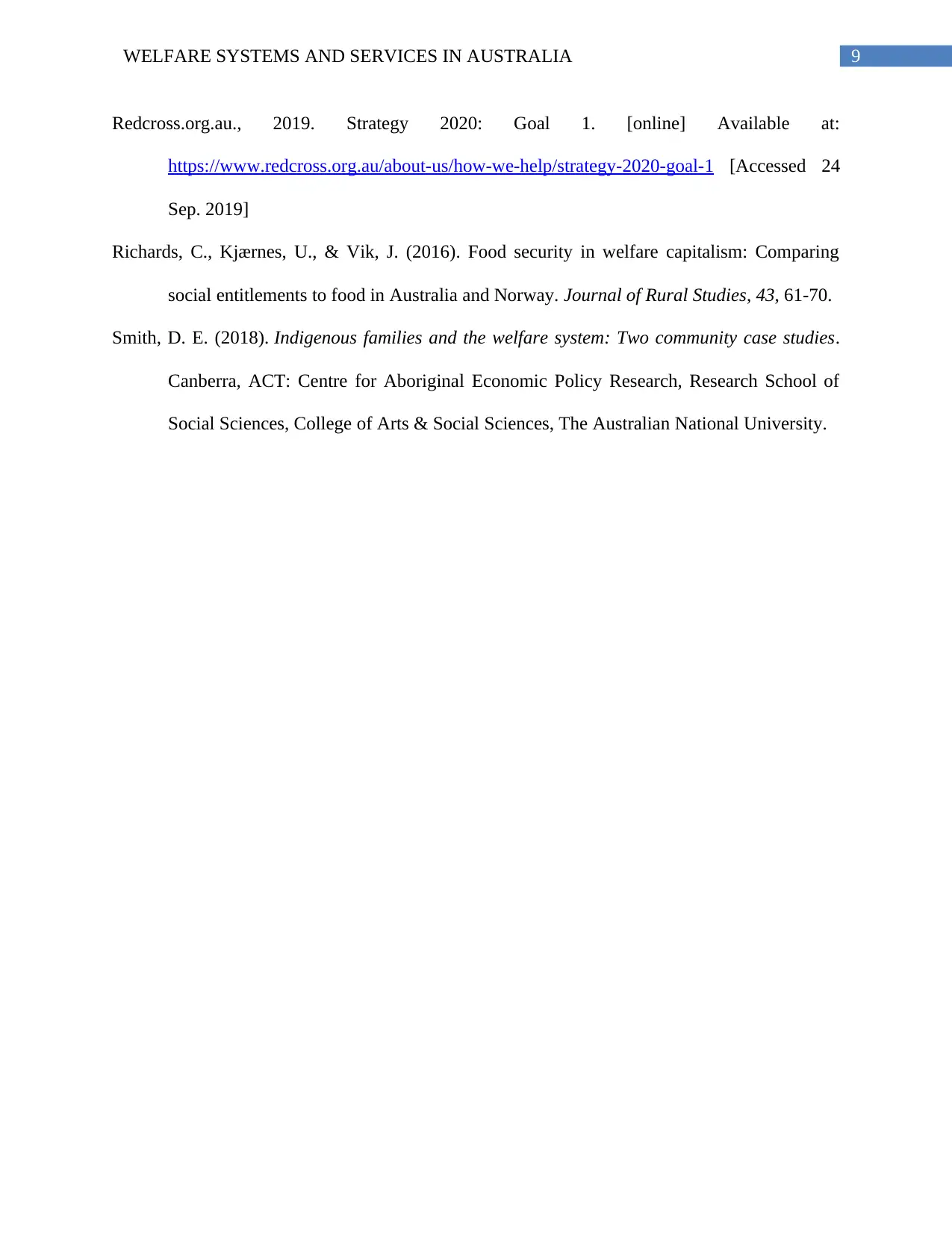
9WELFARE SYSTEMS AND SERVICES IN AUSTRALIA
Redcross.org.au., 2019. Strategy 2020: Goal 1. [online] Available at:
https://www.redcross.org.au/about-us/how-we-help/strategy-2020-goal-1 [Accessed 24
Sep. 2019]
Richards, C., Kjærnes, U., & Vik, J. (2016). Food security in welfare capitalism: Comparing
social entitlements to food in Australia and Norway. Journal of Rural Studies, 43, 61-70.
Smith, D. E. (2018). Indigenous families and the welfare system: Two community case studies.
Canberra, ACT: Centre for Aboriginal Economic Policy Research, Research School of
Social Sciences, College of Arts & Social Sciences, The Australian National University.
Redcross.org.au., 2019. Strategy 2020: Goal 1. [online] Available at:
https://www.redcross.org.au/about-us/how-we-help/strategy-2020-goal-1 [Accessed 24
Sep. 2019]
Richards, C., Kjærnes, U., & Vik, J. (2016). Food security in welfare capitalism: Comparing
social entitlements to food in Australia and Norway. Journal of Rural Studies, 43, 61-70.
Smith, D. E. (2018). Indigenous families and the welfare system: Two community case studies.
Canberra, ACT: Centre for Aboriginal Economic Policy Research, Research School of
Social Sciences, College of Arts & Social Sciences, The Australian National University.
1 out of 10
Related Documents
Your All-in-One AI-Powered Toolkit for Academic Success.
+13062052269
info@desklib.com
Available 24*7 on WhatsApp / Email
![[object Object]](/_next/static/media/star-bottom.7253800d.svg)
Unlock your academic potential
© 2024 | Zucol Services PVT LTD | All rights reserved.





